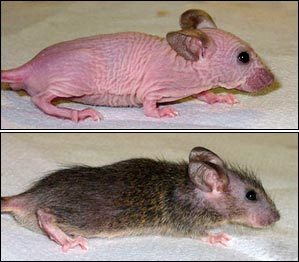
|
| © |
| Evidence shows mice can regenerate hair follicles |
The scientists made the advance after identifying a mechanism that relies on reawakening dormant genes. A US company, Follica Inc, has now licensed the technology in the hope of developing new treatments for baldness.
While adult mammals can repair injuries to themselves, they lack the ability to rebuild lost parts of their bodies - unlike newts and salamanders which can sprout limbs. Experts previously thought it was equally impossible for adult skin to regenerate hair follicles.
Now it seems adult mice can indeed regenerate hair follicles, according to a study published today by Dr George Cotsarelis of University of Pennsylvania School of Medicine, Philadelphia, and colleagues in the journal Nature.
Rather than turning on stem cells, as thought, the method works by reactivating genes used during development of the embryo. If researchers can control hair growth, then they could potentially find cures for people with hair and scalp disorders, such as scarring alopecia where the skin scars, and there is hair overgrowth.
Wounding, they report, triggers new hair-producing follicles to form, a claim that was first made half a century ago after experiment on rabbits but which was written off as unconvincing. The new work shows the effect is real and a consequence of a molecular signal involving a protein called wnt. Following wounding, the signal increases the number of regenerated hair follicles.
By introducing more wnt, the researchers could make skin regenerate instead of just repair, doubling the number of new hair follicles. To show they were really on to something, the team also show that turning off wnt signalling prevents new follicles from forming. "Wound healing triggered an embryonic state in the skin which made it receptive to receiving instructions from wnt proteins," said Dr Cotsarelis.
The same mechanism could be used to cut scarring too. "We can influence wound healing with wnts or other proteins that allow the skin to heal in a way that has less scarring and includes all the normal structures of the skin, such as hair follicles and oil glands, rather than just a scar," explained Dr Cotsarelis.
The finding follows the team's announcement three years ago that it had found parent cells - stem cells - in mouse hair follicles that can regenerate hair, skin and follicles after being implanted. At the time the team said that it hoped to isolate stem cells and use them to generate new follicles. But in the test tube Dr Cotsarelis and his team were surprised to find that the stem cells did not directly contribute to the growth of follicles. Today's work shows that to form follicles the body "reprograms" other skin (epidermal) cells. However, the new hair did not have pigment.
Dr Cotsarelis and one of his coauthors are listed on a patent application related to-follicle regrowth, owned by the university. He also serves on the scientific advisory board and has equity in the company Follica, that has licensed the patent.
"This is an extremely exciting discovery and shows promise for treatment of follicular disorders such as hair loss and unwanted excess hair," noted Dr Vera Price, director of the University of California, San Francisco Hair Research Centre and scientific advisory board member of Follica
Dr Denis Headon, University of Manchester, said: "Up to now we thought that the number of hair follicles we have is set before we were born and can only go downhill from there. This work shows that new hair follicles are made in adult skin, at least when it is healing a wound. The researchers also found a way to artificially soup up this natural process. It might be simpler than we thought to make new hair follicles as a treatment for hair loss."
Prof Desmond Tobin, University of Bradford said: "This paper provides convincing evidence that the skin has remarkable powers of regeneration. It was long thought that hair follicle development, under physiological conditions, was limited to early developmental process in the embryo. Now Cotsarelis' team have convincingly shown that under the conditions peculiar to the wound-healing environment, the highly complex hair follicle can be created anew from apparently unremarkable cells of the healing epidermis and its underlying dermis.
The implications of this observation are many fold, but principally perhaps for what it tells us about the reprogramming power of adult stem cells, and it applications in regenerative medicine and wound healing."



Reader Comments
to our Newsletter